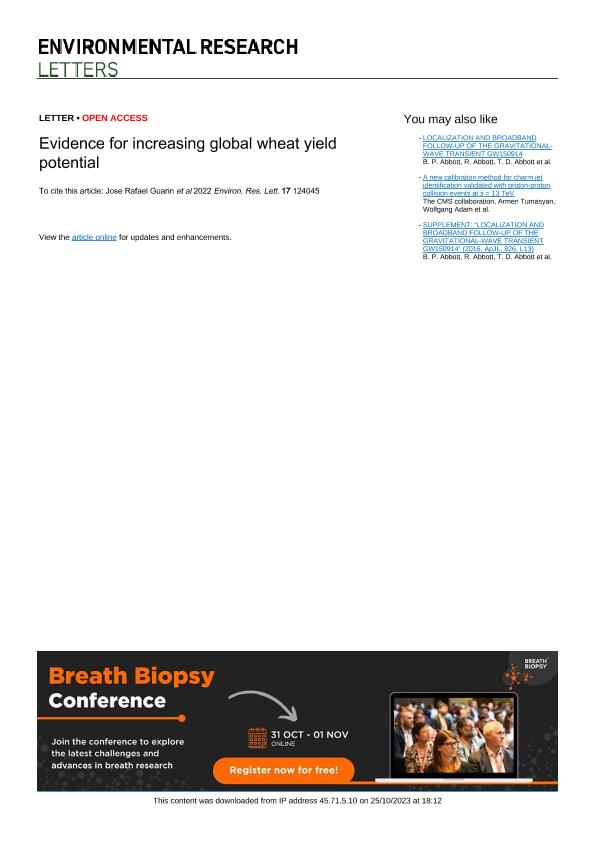Artículo
Evidence for increasing global wheat yield potential
Guarin, Jose Rafael; Martre, Pierre; Ewert, Frank; Webber, Heidi; Dueri, Sibylle; Calderini, Daniel Fernando; Reynolds, Matthew; Molero, Gemma; Miralles, Daniel Julio ; Garcia, Guillermo; Slafer, Gustavo Ariel
; Garcia, Guillermo; Slafer, Gustavo Ariel ; Giunta, Francesco; Pequeno, Diego N.L.; Stella, Tommaso; Ahmed, Mukhtar; Alderman, Phillip D.; Basso, Bruno; Berger, Andres G.; Bindi, Marco; Bracho-Mujica, Gennady; Cammarano, Davide; Chen, Yi; Dumont, Benjamin; Rezaei, Ehsan Eyshi; Fereres, Elias; Ferrise, Roberto; Gaiser, Thomas; Gao, Yujing; Garcia Vila, Margarita; Gayler, Sebastian
; Giunta, Francesco; Pequeno, Diego N.L.; Stella, Tommaso; Ahmed, Mukhtar; Alderman, Phillip D.; Basso, Bruno; Berger, Andres G.; Bindi, Marco; Bracho-Mujica, Gennady; Cammarano, Davide; Chen, Yi; Dumont, Benjamin; Rezaei, Ehsan Eyshi; Fereres, Elias; Ferrise, Roberto; Gaiser, Thomas; Gao, Yujing; Garcia Vila, Margarita; Gayler, Sebastian
 ; Garcia, Guillermo; Slafer, Gustavo Ariel
; Garcia, Guillermo; Slafer, Gustavo Ariel ; Giunta, Francesco; Pequeno, Diego N.L.; Stella, Tommaso; Ahmed, Mukhtar; Alderman, Phillip D.; Basso, Bruno; Berger, Andres G.; Bindi, Marco; Bracho-Mujica, Gennady; Cammarano, Davide; Chen, Yi; Dumont, Benjamin; Rezaei, Ehsan Eyshi; Fereres, Elias; Ferrise, Roberto; Gaiser, Thomas; Gao, Yujing; Garcia Vila, Margarita; Gayler, Sebastian
; Giunta, Francesco; Pequeno, Diego N.L.; Stella, Tommaso; Ahmed, Mukhtar; Alderman, Phillip D.; Basso, Bruno; Berger, Andres G.; Bindi, Marco; Bracho-Mujica, Gennady; Cammarano, Davide; Chen, Yi; Dumont, Benjamin; Rezaei, Ehsan Eyshi; Fereres, Elias; Ferrise, Roberto; Gaiser, Thomas; Gao, Yujing; Garcia Vila, Margarita; Gayler, Sebastian
Fecha de publicación:
12/2022
Editorial:
IOP Publishing
Revista:
Environmental Research Letters
ISSN:
1748-9326
Idioma:
Inglés
Tipo de recurso:
Artículo publicado
Clasificación temática:
Resumen
Wheat is the most widely grown food crop, with 761 Mt produced globally in 2020. To meet the expected grain demand by mid-century, wheat breeding strategies must continue to improve upon yield-advancing physiological traits, regardless of climate change impacts. Here, the best performing doubled haploid (DH) crosses with an increased canopy photosynthesis from wheat field experiments in the literature were extrapolated to the global scale with a multi-model ensemble of process-based wheat crop models to estimate global wheat production. The DH field experiments were also used to determine a quantitative relationship between wheat production and solar radiation to estimate genetic yield potential. The multi-model ensemble projected a global annual wheat production of 1050 ± 145 Mt due to the improved canopy photosynthesis, a 37% increase, without expanding cropping area. Achieving this genetic yield potential would meet the lower estimate of the projected grain demand in 2050, albeit with considerable challenges.
Archivos asociados
Licencia
Identificadores
Colecciones
Articulos(IFEVA)
Articulos de INST.D/INV.FISIOLOGICAS Y ECO.VINCULADAS A L/AGRIC
Articulos de INST.D/INV.FISIOLOGICAS Y ECO.VINCULADAS A L/AGRIC
Citación
Guarin, Jose Rafael; Martre, Pierre; Ewert, Frank; Webber, Heidi; Dueri, Sibylle; et al.; Evidence for increasing global wheat yield potential; IOP Publishing; Environmental Research Letters; 17; 12; 12-2022; 1-14
Compartir
Altmétricas



